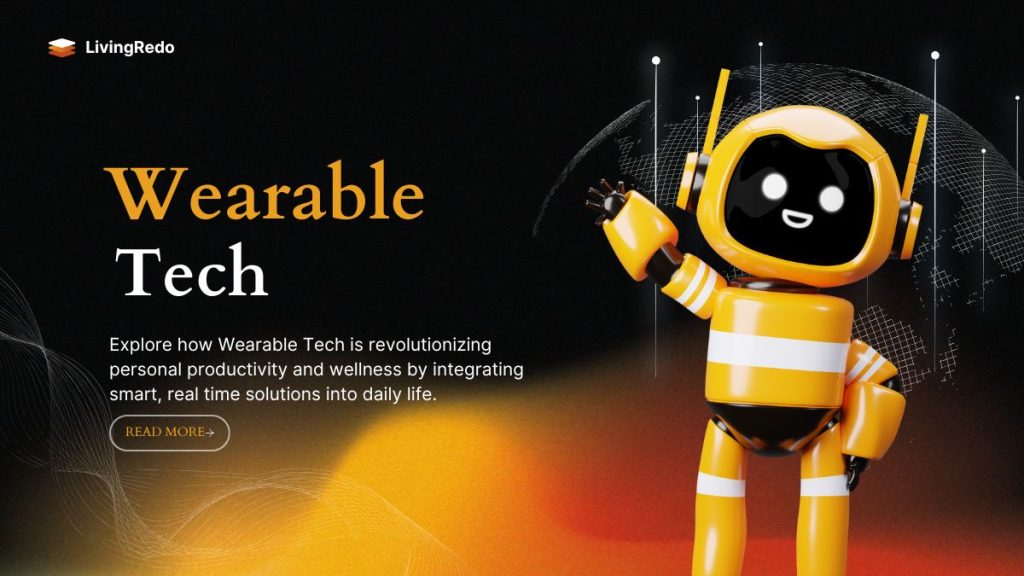Wearable Tech
In the age of intelligent systems and seamless integration, wearable tech: the next wave in personal productivity and wellness stands as one of the most exciting advancements in smart technology. As part of the broader movement discussed in The Future of Smart Technology in Everyday Life, wearable devices are redefining how we live, work, and take care of our health on a deeply personal level.
From smartwatches that monitor your heart rate and sleep cycles to fitness bands that track movement and AI-powered glasses that assist with real-time communication, wearable technology is not just trendy—it’s transforming human potential.
The Connection Between Smart Living and Wearable Tech
In our pillar article The Future of Smart Technology in Everyday Life, we explored how interconnected devices—from smart homes to autonomous transport—are revolutionizing everyday tasks. Wearable tech sits at the heart of this evolution, bringing smart capabilities closer to the body, and ultimately, to the individual’s daily function.
While smart homes manage your environment, wearable tech manages you—your health, your performance, your communication, and even your safety. Together, these innovations form a symbiotic relationship that defines next-generation living.
How Wearable Tech Boosts Personal Productivity
1. Real-Time Data for Better Decisions
Smartwatches and wearable fitness trackers provide real-time feedback on your physical and mental performance. For professionals, this data can translate into improved time management, reduced fatigue, and optimized productivity cycles.
2. Hands-Free Communication
Wearables like smart glasses and earbuds enable professionals to stay connected without interrupting workflow. Voice-controlled actions and notifications reduce distractions and enhance focus during critical tasks.
3. Task Automation and Smart Alerts
Many wearables integrate with calendars, to-do lists, and productivity apps. With AI capabilities, they can recommend breaks, prioritize tasks, and even analyze your energy levels to suggest the best time for deep work.
4. Seamless Office Integration
Modern workplace solutions like Microsoft Viva or Slack-compatible wearables sync data between devices, making it easier to transition between on-the-go activities and desk work. This connectivity brings the office wherever you are.
Wearable Tech and Wellness: A Holistic Approach
1. Health Monitoring
From Apple Watches to Fitbit Charge 6 and Garmin wearables, real-time health monitoring is a staple feature. Track everything from blood oxygen levels to ECG, allowing early detection of health concerns and personalized wellness management.
2. Sleep Optimization
Smart rings and wristbands like the Oura Ring use biometric tracking to evaluate sleep patterns. This helps users improve rest quality—a vital factor for both mental health and workplace efficiency.
3. Stress and Mental Health Tracking
Many modern wearables offer mindfulness tools, stress-level detection, and guided breathing exercises. Some devices, like the Fitbit Sense 2, include EDA sensors to help users manage stress proactively.
4. Fitness Motivation
Wearables gamify fitness through goal setting, challenges, and rewards. By keeping wellness front and center, User are more likely to sticks to their exercise regimens.
Innovations on the Horizon: What’s Next in Wearable Tech?
The upcoming generation of wearables is set to deliver as AI and machine learning continue to progress:
- Personalized AI coaching: Wearables will soon act as your 24/7 health and productivity advisor.
- Wearable biosensors: Ultra-compact sensors will be embedded into clothing or even skin patches.
- Augmented reality wearables: Smart glasses will transition from enterprise tools to daily consumer use, offering real-time translations, navigation, and remote collaboration.
- Emotion tracking: Future devices may use biometric and facial analysis to understand and respond to your emotional state in real time.
These innovations align closely with broader smart tech trends—autonomous ecosystems, hyper-personalization, and sustainable living—all explored in The Future of Smart Technology in Everyday Life.
The Role of AI and Cloud Integration
AI is the invisible engine behind wearable tech. From predictive analytics to automated reminders and health insights, artificial intelligence enables wearables to offer personalized feedback and actionable recommendations.
Additionally, cloud integration allows for data backup, cross-platform access, and long-term analysis. Users can seamlessly connect their wearable devices with their smart home systems, work tools, or healthcare providers, creating a fully connected ecosystem that supports productivity and wellness in every environment.
Real-Life Applications of Wearable Tech
In the Workplace
Companies are integrating wearables into employee wellness programs. For instance, warehouse workers use smart bands to monitor fatigue, while executives use biometric rings to manage stress and optimize performance.
In Healthcare
Wearables are revolutionizing telemedicine. Patients can share real-time health metrics with doctors, enabling early diagnosis and remote care—crucial in post-pandemic healthcare systems.
In Sports and Fitness
Wearable technology is used by athletes and fitness enthusiasts to optimise training, avoid injuries, and track recuperation. AI-powered feedback helps optimize results while minimizing risks.
In Daily Life
From parents monitoring their child’s GPS location via smart bands to seniors using fall-detection wearables for safety, the everyday uses of wearable tech are as diverse as the users themselves.
Challenges and Considerations
While wearable tech is powerful, there are a few considerations to keep in mind:
- Privacy & Data Security: Wearables collect sensitive health and location data. Strong encryption and user consent protocols are essential.
- Battery Life: With increasing functionality, maintaining long battery life is a constant challenge.
- User Comfort & Design: For mass adoption, wearables must be both functional and fashionable—blending effortlessly into daily life.
- Accessibility: Affordability and compatibility across platforms are crucial for widespread use, especially in developing markets.
Frequently Asked Questions
Final Thoughts
Wearable tech: the next wave in personal productivity and wellness represents a pivotal moment in the journey toward smarter, more connected living. These devices aren’t just gadgets—they are tools of transformation, offering measurable improvements to how we work, live, and thrive.
As wearable technology continues to evolve, it complements the broader shifts explored in The Future of Smart Technology in Everyday Life, forming the building blocks of a smarter, healthier, and more efficient world.
